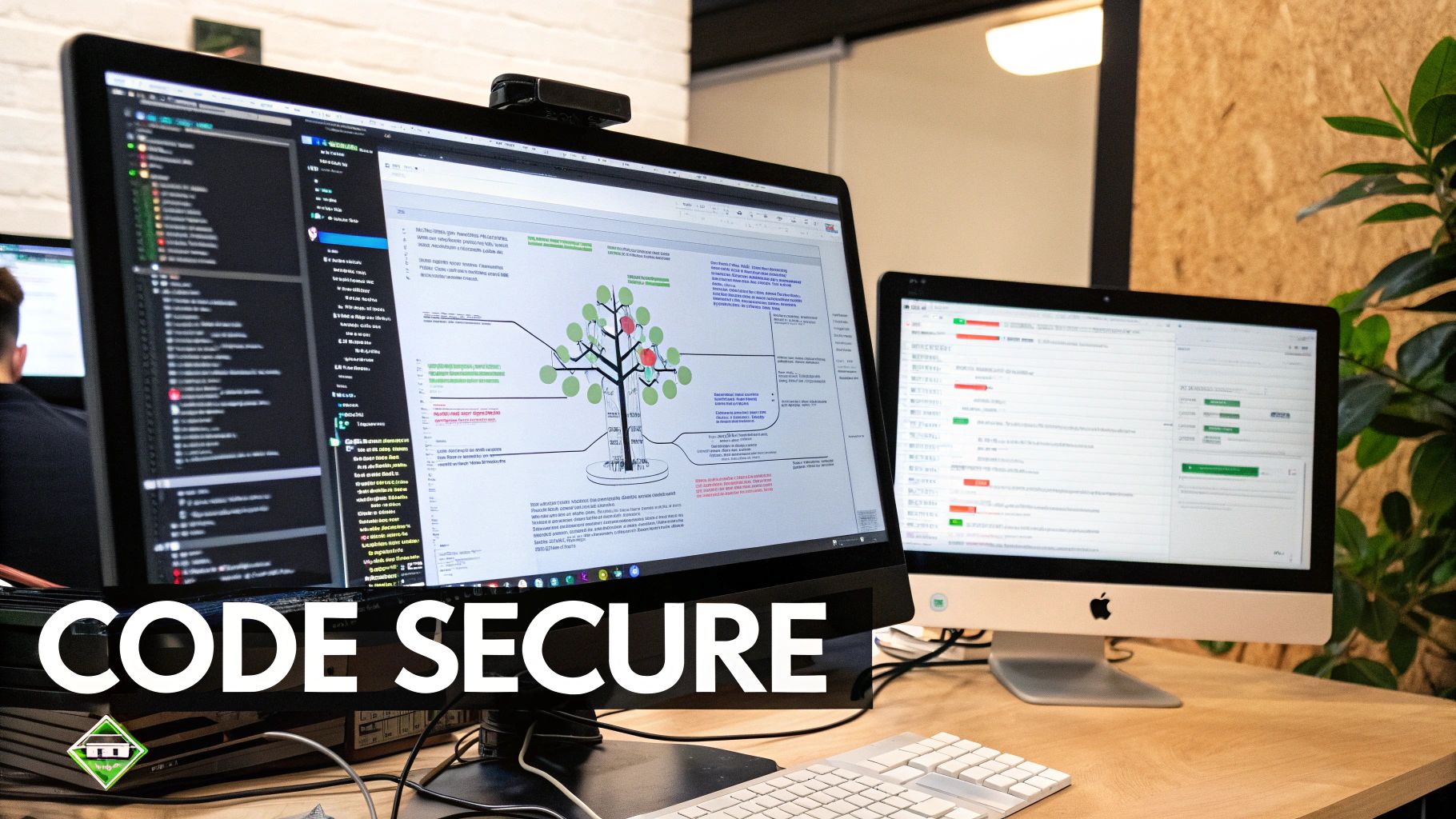7 Point GitHub Projects Checklist for Success
Level Up Your GitHub Projects
GitHub has transformed software development. It's grown from a simple Git repository hosting service into the central hub for collaborative coding. Today, it's the industry standard for version control, hosting everything from personal projects to large-scale applications used by millions. But simply uploading your code isn’t enough to truly benefit from this powerful platform.
In the past, software development collaboration and code management were often disorganized. This frequently led to integration problems and project delays. Version control systems like Git offered a solution, and platforms like GitHub expanded on this by creating a centralized, collaborative space. This evolution has significantly changed how teams work, allowing for distributed development and encouraging open-source contributions.
What truly makes a GitHub project stand out? It's the combination of well-defined processes, automated workflows, and a focus on quality. These elements distinguish successful projects from the rest. This seven-point checklist will provide you with essential best practices, no matter your role.
Essential GitHub Best Practices
-
Clearly Defined Roles and Responsibilities: Ensure everyone on the team understands their role in the project.
-
Comprehensive Documentation: Good documentation helps onboard new team members and clarifies project goals.
-
Effective Branching Strategy: Implement a branching strategy like Gitflow to manage code changes effectively.
-
Automated Testing and Continuous Integration: Automate your testing process to catch bugs early and integrate code changes seamlessly. Consider using tools like Jenkins or CircleCI.
-
Meaningful Code Reviews: Conduct thorough code reviews to maintain code quality and share knowledge within the team.
-
Issue Tracking and Project Management: Use GitHub's built-in issue tracker to manage bugs, feature requests, and overall project progress.
-
Consistent Communication: Maintain open communication within the team through comments, discussions, and regular updates.
Whether you're a Data Scientist managing datasets, a DevOps Engineer working on deployments, a Mobile Engineer building an app, an Engineering Manager overseeing multiple projects, or a Computer Science Teacher guiding future developers, these practices apply. By implementing these strategies, you can optimize your GitHub projects for maximum impact, encourage collaboration, ensure code quality, and achieve project success.
Comprehensive Documentation

Thorough documentation is essential for any successful GitHub project. It's the key to transforming code into a usable and understandable resource, making it easier for others to contribute. Think of it as a combined instruction manual, onboarding guide, and project history. Good documentation bridges the gap between code and comprehension for everyone, from Data Scientists and Software Engineers to Product Managers and Computer Science Teachers.
A well-documented project is much easier for newcomers to understand. Imagine a DevOps Engineer looking at your project. A clear README with setup and usage examples lets them quickly understand its value. Similarly, detailed contribution guidelines empower a Mobile Engineer to easily fix bugs or add features. This accessibility builds a thriving community. Without it, potential contributors might be discouraged.
Core Components of Documentation
What does comprehensive documentation entail? Here are some key elements:
- README.md: The project's front page, offering an overview, installation instructions, usage examples, and often a quick start guide.
- CONTRIBUTING.md: This file outlines the contribution process, including coding style, branching strategies, and pull requests. It's vital for open-source projects, ensuring smooth collaboration.
- CODE_OF_CONDUCT.md: This document sets community behavior expectations, fostering a welcoming and respectful environment.
- API Documentation: For projects with public interfaces, clear API documentation is crucial. It explains functions, classes, and parameters, enabling integration with other projects.
- Setup and Development Workflows: Documents about setting up a development environment, testing, and debugging save time for everyone involved.
Benefits of Documentation
The benefits extend beyond onboarding. Good documentation minimizes repetitive questions, serving as a central knowledge base. This frees up maintainers to focus on development. Well-documented projects are also easier to find. Search engines can index the content, increasing visibility.
Creating and maintaining this documentation takes effort, especially for complex projects. Keeping it current is an ongoing challenge. You might be interested in: [Strategies for Keeping Documentation Up-to-Date]. For larger projects, tools like Docusaurus or GitHub Pages can help. Consider using markdown templates for consistency and include visuals like screenshots and diagrams. Automated documentation checks in your CI/CD pipeline also maintain quality.
Pros and Cons of Detailed Documentation
| Pros | Cons | |-----------------------------------------|------------------------------------------| | Easier for new contributors | Time-consuming to create and maintain | | Fewer repetitive questions | Can become outdated | | Centralized project knowledge base | May require additional tools/platforms | | Improved project discoverability | |
Example Projects With Excellent Documentation
- React: Extensive documentation with interactive examples.
- TensorFlow: Multi-tiered documentation catering to different user groups.
- VS Code: Clear contribution workflows, encouraging community involvement.
Tips for Effective Documentation
- Use markdown templates for consistency.
- Include screenshots and diagrams.
- Set up documentation review processes.
- Implement automated documentation checks in your CI/CD pipeline.
- Use Docusaurus or GitHub Pages for larger projects.
Further reading: [Best Practices for README files]. Sitemaps, like the one found at https://www.pullchecklist.com/sitemap-0.xml, also help organize large projects. Investing in comprehensive documentation is investing in the long-term success of your project.
Consistent GitHub Issue Management
A disorganized GitHub issue tracker can quickly become a major obstacle for any project. It hinders smooth collaboration and slows down development. Consistent GitHub Issue Management is essential for efficient communication, progress tracking, and maintaining a healthy project. It transforms the issue tracker from a simple list of problems into a powerful tool for project management and effective collaboration. This is why it’s a critical part of any successful GitHub project.
A structured approach to issue management ensures that bugs, feature requests, and general project tasks are properly documented, prioritized, and addressed. This creates transparency in the development process and makes it easier for contributors, maintainers, and even end-users to work together.
Key Features of Effective Issue Management
- Issue Templates: Pre-defined templates for bugs, features, and other common reports ensure consistency and collect all the necessary information from the start. This saves time and reduces back-and-forth communication.
- Clear Labeling System: A well-defined labeling system categorizes and prioritizes issues, simplifying filtering, searching, and tracking progress. Examples include labels like
bug,enhancement,documentation, andpriority:high. - Milestone Tracking: Connecting issues with milestones creates a roadmap of the project's progress and helps track deadlines.
- Automated Issue Triage Workflows: Automating tasks like assigning labels, adding issues to projects, or requesting further information streamlines the triage process, freeing up maintainers’ time.
- Linked Issues and Pull Requests: Linking related issues and pull requests provides context and traceability, making it easier to understand the connections between different parts of the project.
Advantages of Effective Issue Management
- Standardized Issue Reporting: Consistent formatting simplifies understanding and processing of issues.
- Improved Issue Discovery and Categorization: Labels and milestones make finding and filtering relevant issues easier.
- Project Health and Progress Metrics: Tracking the number of open/closed issues, time to resolution, and other metrics helps gauge project health.
- Enhanced Communication: A well-managed issue tracker promotes clear communication and reduces ambiguity between maintainers and contributors.
Potential Challenges of Issue Management
- Overwhelming Volume: Popular projects with high issue volumes require dedicated resources and efficient workflows.
- Ongoing Maintenance: The labeling system and templates need to be updated as the project evolves.
- Need for Additional Tools: Projects with complex requirements might need to integrate with dedicated project management tools.
Real-World Examples of Effective Issue Management
- Vue.js: Vue.js uses a comprehensive issue template system to guide contributors in providing thorough bug reports and feature requests, ensuring maintainers have the information they need.
- Kubernetes: The Kubernetes project employs a highly organized issue triage process, using automation and a detailed labeling system to manage the high volume of issues they receive.
- Microsoft's Azure SDK: Microsoft’s Azure SDK benefits from a comprehensive label taxonomy, categorizing issues by service, impact, and priority for efficient tracking and management.
Practical Tips for Implementing Effective Issue Management
- Create Custom Issue Templates: Define templates with required fields for various issue types (bugs, features, etc.).
- Set Up GitHub Issue Labels: Use a consistent color scheme and clear descriptions for labels.
- Implement GitHub Actions for Automatic Issue Triage: Automate tasks like assigning labels based on defined rules.
- Establish SLAs for Initial Responses: Set expectations for response times to new issues.
- Regularly Review and Close Stale Issues: Keep the issue tracker clean and focused by closing irrelevant issues.
Evolution and Growing Popularity of Issue Management Tools
GitHub's built-in issue templates have greatly simplified issue management. The rise of automation tools like Probot further enhanced this process by enabling automated triage workflows. Integration with project management platforms like ZenHub offers even more advanced features for managing complex projects.
By implementing consistent GitHub Issue Management practices, projects can improve communication, enhance collaboration, and ultimately deliver higher-quality software.
Automated CI/CD Pipelines

Automated CI/CD pipelines are essential for modern software development. They form the backbone of efficient and reliable release processes. By automating the integration of code changes, testing, building, and deployment, teams can deliver high-quality software faster and with fewer errors. This automation makes CI/CD a key component of any robust project checklist on GitHub.
Continuous Integration (CI) focuses on automatically integrating code changes from multiple contributors into a shared repository. With each integration, automated tests and checks are triggered, catching potential issues early in the development cycle. Continuous Deployment (CD) extends this process by automating the deployment of tested and built code to staging or production environments. Together, CI/CD creates a smooth transition from code commit to release.
Features and Benefits of CI/CD
Automated CI/CD pipelines offer several features that streamline the software development lifecycle:
- Automated Testing on Pull Requests: Every code change is thoroughly tested before merging.
- Code Quality and Linting Checks: Coding standards are enforced, and potential style issues or code smells are identified automatically.
- Security Vulnerability Scanning: Security checks are integrated to identify and address potential vulnerabilities early.
- Automated Build Processes: Compilation, packaging, and other build-related tasks are automated.
- Deployment to Staging/Production: The deployment process is automated, reducing manual intervention and potential errors.
- Release Automation: Release creation and management, including versioning and tagging, are automated.
Pros and Cons of CI/CD
Implementing CI/CD offers significant advantages, but it's important to consider the potential drawbacks as well.
| Pros | Cons | |--------------------------------------|-----------------------------------------------------------| | Catches issues early | Initial setup can be complex | | Enforces coding standards consistently | May require cloud resources and associated costs | | Reduces manual testing burden | Can be challenging to debug pipeline failures | | Accelerates feature delivery | May add overhead to small projects | | Provides confidence in code changes | |
Examples and Evolution of CI/CD
The rise of cloud computing and the DevOps movement significantly increased the adoption of CI/CD. Platforms like GitHub Actions, Travis CI, CircleCI, Jenkins, and Azure DevOps have simplified CI/CD pipeline implementation.
- Next.js and Vercel: Vercel provides a seamless CI/CD experience for deploying Next.js applications.
- Rust's CI Testing: Rust's comprehensive CI testing matrix ensures language stability.
- GitHub's Octokit Libraries: GitHub's own CI workflows demonstrate best practices for implementation.
Practical Tips for CI/CD Implementation
- Start Simple with GitHub Actions: Leverage the tight integration with GitHub repositories.
- Cache Dependencies: Significantly reduce build times by caching dependencies.
- Configure Status Checks: Protect important branches by enforcing passing CI checks before merging.
- Set up Notifications: Receive timely alerts about pipeline issues.
- Progressive Implementation: Start with basic checks and gradually add more sophisticated testing and deployment stages.
By implementing automated CI/CD pipelines, development teams can significantly improve their workflow efficiency, code quality, and release velocity. The initial investment in setting up these pipelines results in reduced errors, faster development cycles, and increased confidence in code changes over time.
Semantic Versioning and Release Management
Maintaining a healthy release cycle is crucial for any software project, especially when collaboration is key, like on GitHub. This is where Semantic Versioning (SemVer) and structured release management become essential. They provide a reliable foundation, making it easier for users to understand updates, manage dependencies, and integrate your software. This careful versioning builds trust and encourages wider adoption.
SemVer uses a MAJOR.MINOR.PATCH system to communicate changes:
- MAJOR: Signifies incompatible API changes.
- MINOR: Adds backwards-compatible functionality.
- PATCH: Includes backwards-compatible bug fixes.
Combining SemVer with robust release management offers a consistent approach to handling updates. This includes:
- Detailed CHANGELOGs: A meticulously maintained CHANGELOG provides a historical record of every change, enabling users to track the project’s evolution.
- Release Notes: Summarize key changes for each release, highlighting new features, bug fixes, and any breaking changes.
- Git Tags: Tagging each release in Git links the version number to the codebase, simplifying rollbacks and comparisons.
- GitHub Releases: Bundling compiled binaries and other artifacts with each release through GitHub Releases makes them readily accessible.
Benefits of a Structured Approach
Using SemVer and a well-defined release process provides several advantages:
- Predictability: Users know what to expect with each update, minimizing the risk of unexpected disruptions.
- Clear Communication: The
MAJOR.MINOR.PATCHsystem clearly conveys the impact of each update. - Simplified Dependencies: SemVer enables dependency management tools to automatically find compatible versions, streamlining updates.
- Change History: The CHANGELOG offers a comprehensive audit trail of the project's progress.
- Automation: Predictable versioning allows for automated updates, increasing efficiency.
Challenges to Consider
While beneficial, there are challenges to implementing SemVer and structured release management:
- Discipline: Requires consistent adherence to SemVer rules from all contributors.
- Version Bumping: Deciding on the appropriate level of version increment (MAJOR, MINOR, or PATCH) can sometimes be difficult.
- CHANGELOG Maintenance: Maintaining a detailed CHANGELOG requires ongoing effort.
Real-World Examples
Many popular projects successfully utilize SemVer:
- Node.js: Known for its strict adherence to SemVer, ensuring clear communication about breaking changes.
- Angular: Follows predictable release cycles with deprecation periods, giving developers time to adapt.
- Symfony: Uses Long Term Support (LTS) releases alongside standard releases for production stability.
Practical Tips
Here are some practical tips for implementation:
- Conventional Commits: Automate versioning and CHANGELOG generation using the Conventional Commits specification.
- Release Drafter: Automate draft release notes based on pull requests and commits with the Release Drafter GitHub Action.
- Automated CHANGELOG Generation: Use tools like
standard-versionfor automatic CHANGELOG updates based on commit history. - Release Branches: Isolate major version development for thorough testing.
- Release Candidates: Test significant changes with a wider audience before official release.
Origins and Growth
SemVer (semver.org) has become an industry standard, largely thanks to the growth of the npm ecosystem and GitHub's release features. Conventional Commits further streamlines the release process, enabling greater automation.
By adopting SemVer and a structured release management process, you enhance your project's reliability and trustworthiness, making it more attractive to users and easier to integrate into professional workflows. This practice is essential for any project aiming for broader reach and sustained success.
Code Quality Tools and Standards
Maintaining high code quality is essential for any software project. This is especially critical in collaborative projects where developers with diverse coding styles and experience levels contribute. Inconsistent code can lead to confusion, bugs, and challenges in maintaining and scaling the project. Therefore, establishing code quality tools and standards is a vital part of any GitHub project checklist.
This means integrating various tools and practices into the development process. These ensure code consistency, maintainability, and reliability.
- Linting Rules and Configuration: Linters like ESLint (for JavaScript), Pylint (for Python), or RuboCop (for Ruby) analyze code for style errors and potential bugs. They enforce pre-defined rules or custom configurations.
- Code Formatters: Tools like Prettier automatically format code based on a style guide. This creates a uniform look across the codebase.
- Static Analysis: Tools like SonarQube perform in-depth code analysis. They identify potential bugs, security vulnerabilities, and code smells.
- Type Checking: Languages like TypeScript and MyPy introduce type checking. This helps developers catch type-related errors during development.
- Code Complexity Metrics: Measuring code complexity identifies difficult-to-understand sections that may need simplification.
- Test Coverage Requirements: Minimum test coverage targets ensure that a significant portion of the codebase is tested. This reduces the likelihood of regressions.
Benefits of Code Quality Tools
- Consistent Code Style: Improves readability and collaboration.
- Automated Bug Detection: Catches common bugs and anti-patterns early.
- Reduced Technical Debt: Enhances maintainability and lowers long-term costs.
- Simplified Onboarding: Provides clear guidelines for new contributors.
- Efficient Code Reviews: Reviewers can focus on logic and functionality.
Challenges of Code Quality Tools
- Initial Setup Time: Configuring tools and rules requires upfront effort.
- Learning Curve: New contributors may need time to adapt to new tools.
- False Positives: Tools may flag issues that aren't actual bugs.
- Tool Maintenance: Keeping tools and configurations updated takes effort.
Examples of Code Quality in Action
- Airbnb JavaScript Style Guide: A widely used JavaScript style guide often enforced with ESLint.
- Google's Static Analysis: Google utilizes advanced static analysis tools for its large codebases.
- Microsoft's TypeScript: TypeScript's type system enables early detection of type-related errors.
Implementing Code Quality Tools
- Document Standards: Create a comprehensive style guide.
- Pre-Commit Hooks: Use tools like Husky to run linters and formatters before each commit.
- IDE Integration: Integrate tools into IDEs for real-time feedback.
- Start with Standards: Begin with industry-standard configurations and customize as needed.
- Language-Specific Tools: Use tools like Prettier, ESLint, or Black, depending on the language.
Tools to Consider
Key tools include ESLint, Prettier, SonarQube, Husky, and EditorConfig.
Code quality tools have evolved significantly. Early linters focused on style. Modern tools now encompass static analysis, type checking, and other techniques to boost code reliability and maintainability. Integrating these tools into your GitHub project is an investment in its long-term success.
Branch Protection and Code Review: A Vital GitHub Checklist Item

Branch protection and well-structured code review workflows are essential for any project hosted on GitHub. These practices are crucial for maintaining code quality, security, and overall project stability. They foster a collaborative environment where changes undergo thorough vetting before integration into the main codebase. This explanation is relevant for a wide range of technical roles, from Data Scientists to IT Analysts.
Protecting key branches, such as main or develop, prevents direct commits and ensures peer reviews. This usually means requiring a specific number of approvals from designated reviewers before a pull request (PR) can be merged. Platforms like GitHub, GitLab, and Gerrit offer robust features to manage these rules.
Branch Protection Features
Here are some common branch protection rules:
- Required Reviews: A minimum number of approvals from colleagues is mandatory.
- Required Status Checks: Integration with CI/CD pipelines ensures all tests pass before merging.
- Signed Commit Enforcement: Digitally signed commits bolster security and auditability.
- Pull Request Templates: Standardized templates maintain consistency in PRs, requiring details like change descriptions, testing procedures, and linked issue numbers.
- Code Owners Approval:
CODEOWNERSfiles automate review requests from responsible individuals or teams. - Automated Review Assignments: This feature efficiently distributes the review workload.
Advantages of Branch Protection and Code Review
Implementing these workflows offers significant benefits:
- Preventing Accidental Changes: Direct commits to the main branch are restricted, safeguarding its integrity.
- Pre-Deployment Reviews: This reduces the chance of bugs or vulnerabilities reaching production.
- Improved Code Quality: Shared responsibility promotes higher coding standards.
- Knowledge Sharing: Code discussions and feedback create valuable learning opportunities.
- Project Stability: Thoroughly vetted changes minimize disruptions and regressions.
Potential Drawbacks
While beneficial, there are some potential downsides:
- Slower Development: Review steps add time to the merge process.
- Reviewer Bottlenecks: Limited reviewers can create delays, particularly in smaller teams.
- Cultural Shift: Effective reviews require a culture of constructive feedback.
- Overly Restrictive: Strict rules might hinder small, agile teams.
Real-World Examples
Code review's importance is evident in large-scale projects. The Linux kernel's rigorous process exemplifies how meticulous reviews contribute to a complex system's stability. Similarly, Google's Chromium project and Meta's (formerly Facebook's) Phabricator-based system showcase the evolution of sophisticated code review workflows. Platforms like GitHub and GitLab have democratized these features, making them accessible to all.
Practical Implementation Tips
Here are some practical tips for getting started:
- Use
CODEOWNERS: Delegate responsibility and automate review requests. - Implement PR Templates: Ensure consistency and capture essential information.
- Establish Clear Standards: Define criteria for code quality, style, and testing.
- Configure Branch Protection: Balance security and speed by adjusting enforcement levels.
- Use Review Apps: Deploy changes to a temporary environment for visual and functional verification.
For more on site structure and content organization, explore this resource: https://www.pullchecklist.com/sitemap-0.xml. Also, consider reading more about Effective Code Review Practices for Engineering Teams. By implementing these strategies, you can significantly enhance code quality, collaboration, and risk mitigation within your GitHub projects.
Security and Dependency Management

In the interconnected world of software development, security and dependency management are essential for any successful GitHub project. These practices ensure your projects are secure, current, and compliant, building trust with users and contributors. They protect against vulnerabilities, maintain up-to-date dependencies, and manage the legal aspects of open-source software.
This is why it's a critical part of any GitHub project checklist.
Key Features of Robust Management
Solid security and dependency management involves several important features:
- Automated Dependency Updates: Tools like Dependabot automate dependency updates, saving time and ensuring you use the latest, most secure versions.
- Security Vulnerability Scanning: Regular vulnerability scans are crucial. Tools like GitHub's CodeQL and Snyk help find weaknesses before they're exploited.
- License Compliance Checking: Understanding dependency licenses is vital for legal compliance. Automated tools can identify licenses and flag potential conflicts.
- SECURITY.md File: A clear security policy, documented in a SECURITY.md file, outlines the process for reporting and handling vulnerabilities. This transparency promotes trust and a secure development environment.
- Secret Scanning: Accidentally committing secrets (like API keys or passwords) is a serious risk. GitHub and other platforms offer secret scanning to detect and alert you to these exposures.
- Regular Security Audits: Periodic audits provide a comprehensive security assessment, helping identify and address vulnerabilities proactively.
Advantages of Strong Security Practices
The benefits of these practices are substantial:
Pros:
- Reduced Vulnerabilities: Proactive measures minimize the risk of exploits.
- License Compliance: Ensures proper license usage and avoids legal issues.
- Increased Trust: Transparency and a security commitment build user and contributor confidence.
- Up-to-Date Dependencies: Keeps your project current and reduces technical debt.
- Clear Reporting Process: Facilitates quick responses to vulnerabilities.
Potential Challenges
While the benefits are clear, there are some challenges to consider:
Cons:
- Breaking Changes: Dependency updates can introduce breaking changes, requiring thorough testing.
- False Positives: Security tools can generate false positives, needing investigation.
- Maintenance Time: Implementation requires ongoing effort and dedicated time.
- Dependency Complexity: Managing dependencies in large projects can become complex.
Industry Best Practices
The importance of these practices has grown with the rise of open-source and complex systems. Examples like npm's use of Dependabot, Rails' security policy, and Mozilla's bug bounty program demonstrate the industry's focus on security. More resources can be found at https://www.pullchecklist.com/sitemap-0.xml.
Getting Started
Here are some implementation tips:
- Automate dependency updates with Dependabot.
- Use CodeQL for security analysis.
- Implement Snyk or a similar tool for deeper scanning.
- Create a SECURITY.md file outlining your security policy and reporting procedures.
- Set up automated vulnerability alerts.
Tools like WhiteSource Bolt and OWASP Dependency-Check have simplified these practices, making them accessible to projects of all sizes. By proactively addressing security and dependency management, you create a more robust, reliable, and trustworthy project. Read also: Best Practices for Secure Dependency Management.
7-Point GitHub Projects Checklist Comparison
| Title | Core Features ★ | User Experience 👥 | Unique Features ✨ | Value/Price 💰 | |------------------------------------------|-------------------------------------------------------|-------------------------------------------|-----------------------------------------------------|------------------------------------------------| | Comprehensive Documentation | README, CONTRIBUTING, API docs | Smooth onboarding, clear guidance | Detailed, searchable docs | Reduces friction, boosts traction | | Consistent GitHub Issues Management | Templates, labels, milestones | Organized, transparent tracking | Standardized issue handling | Enhances collaboration & prioritization | | Automated CI/CD Pipelines | Testing, linting, security scans | Fast feedback, reliable builds | Streamlined deployment processes | Accelerates delivery, minimizes errors | | Semantic Versioning & Release Management | SemVer, CHANGELOG, release notes | Predictable updates, clear version control | Automated version adjustments | Simplifies dependency management | | Code Quality Tools & Standards | Linters, formatters, static analysis | Consistent style, smoother reviews | Reduces technical debt | Improves maintainability, onboarding | | Branch Protection & Code Review Workflows | Protected branches, PR templates, required approvals | Secure, collaborative reviews | Automated assignments, enforced checks | Maintains stability, prevents errors | | Security & Dependency Management | Automated updates, vulnerability scans, audits | Proactive security monitoring | Clear policies, license checks | Builds trust, ensures compliance |
Ready to Elevate Your GitHub Projects?
Implementing effective strategies like comprehensive documentation, consistent issue management, automated CI/CD, semantic versioning, code quality tools, branch protection, and security/dependency management can significantly improve your GitHub projects. Start small, focus on one area, and gradually incorporate the rest. Watch your project thrive!
Here's how to enhance your GitHub workflow:
- Prioritize Documentation: Clear, concise documentation makes your project accessible and understandable.
- Manage Issues Effectively: Track bugs, features, and progress with a consistent issue management system.
- Embrace Automation: CI/CD pipelines (Jenkins is a popular choice) streamline your workflow and minimize manual errors.
- Utilize Versioning: Semantic versioning helps manage releases and dependencies.
- Maintain Code Quality: Tools like SonarQube ensure clean, consistent code.
- Protect Your Code: Implement code review workflows and branch protection to prevent errors and maintain integrity.
- Focus on Security: Regular dependency updates and security audits are crucial.
Staying Ahead of the Curve
The software development world is constantly changing. Trends like DevSecOps and GitOps are shaping the future. Adapting to these trends and continuously learning new tools and techniques is essential for staying relevant and efficient. Regularly review your processes, gather team feedback, and be open to new best practices.
Streamlining Your Code Review Process
Want to improve your project quality on GitHub? Pull Checklist automates and streamlines your code review workflow with powerful, conditional checklists within your pull requests. Enforce best practices, reduce errors, and improve team collaboration, even in unfamiliar code areas. From customizable templates to comprehensive reporting, Pull Checklist empowers your team to deliver higher quality code consistently. Enhance your GitHub workflow today!
